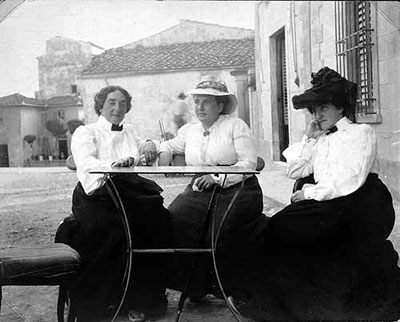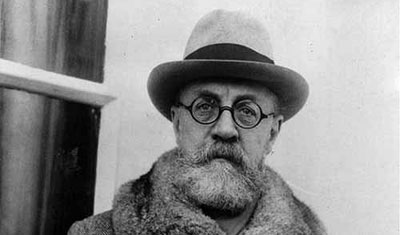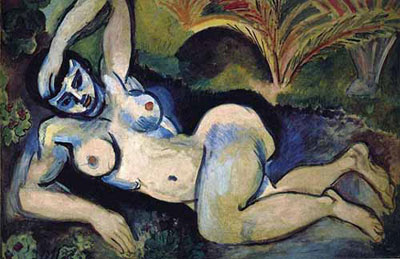|
Playwright Susan McCully lives two blocks from the Baltimore Museum of Art where the art collection of Etta and Claribel Cone hangs. McCully said in an interview conducted by the Steiny Road Poet on March 2, 2018, that her discovery that Etta had had an intimate relationship with Gertrude Stein made her want to write the play All She Must Possess.
Steiny saw All She Must Possess February 23 at the Howard Community College Rep Stage. Because of the strong presence of a playwright inside the play—an actual character known only as Writer—Steiny thought she needed to talk with Susan McCully to fully appreciate this clever piece of Steinian theater.
While McCully populates the play with eight characters, only five actors are employed. Grace Bauer creates the sometimes anxious, sometimes rock-steady Etta Cone who is the focus of this play. Keri Eastridge plays Writer who starts out sure but then is attacked by her own characters.

Valerie Leonard doubles Claribel Cone and Gertrude Stein. As Claribel, Leonard seems fine but as Gertrude, Leonard made Steiny uneasy until Steiny realized the same actor was both Claribel and Gertrude. Characteristically, both Claribel and Gertrude were strong domineering women who had studied medicine at John Hopkins medical school. Thus it makes sense to put these two characters together. But as to their appearance, Claribel was tall and lanky while Gertrude was short and rotund.
Without significant correspondence, Nigel Reed predominately plays Henri Matisse but he also gives the audience a brief look at Gertrude’s brother Leo who introduced the Cone sisters to the Fauvist painter Matisse. As a character Matisse is full of advice. He says, “You must not paint what is but the difference between things.”

Perhaps the most interesting assignment belongs to Teresa Castracane who doubles as the prickly Alice Toklas and Blue Nude. The Blue Nude is a painting by Matisse and this was the last Matisse painting purchased by Leo Stein in 1907 as part of the art collection owned jointly by Gertrude and Leo. When they split up, Leo took this painting. Eventually Claribel bought it in 1926 after it had been bought and sold numerous times.

In its day, The Blue Nude with its primitive drawing of a hard-looking woman was scandalous. Art lovers were used to seeing beautiful nudes with soft curves. By having one actor play both Blue Nude and Alice Toklas, the audience is offered the chance to reflect that the relationship Alice had with Gertrude was also scandalous and that the hardly pretty Alice, who served as Gertrude’s muse, was an interesting comparison with the hard lines of The Blue Nude.
Asked to talk about The Blue Nude, McCully answered that Blue Nude represented Etta and what she could not see about her own beauty. She added that Matisse said that Etta reminded him of The Blue Nude, however, Etta hated that painting.
Steiny asked McCully whose idea was it to double certain characters—hers or director Joseph W. Ritsch. McCully claims that credit. Director Ritsch and his scenic designer Daniel Ettinger did a great job putting the flesh and bones Blue Nude into a window on a wall of the Cone sisters’ home. Certainly the presence of Writer paves the way for Blue Nude stepping out of her portrait onto the stage.
Since Writer is constantly on stage breaking the “Fourth Wall,” Steiny asked McCully if she used this dramatic approach in others of her plays and if she thought it was possible to overuse it. Surprisingly McCulley said she might get rid of the character called Writer while maintaining the belief that it’s important to penetrate that invisible wall between the stage and audience because “the audience is the antagonist.”
For Steiny, having the writer of the play on stage and directing the play’s development is self-conscious, which is not a bad thing. Perhaps McCully’s play models something like Luigi Pirandello’s Six Characters in Search of an Author first performed in 1921. Gertrude Stein started writing plays in 1913. Her plays, such as What Happened (1913) and An Exercise in Analysis (1917) explore process though in a much more radical way (lacking assigned characters and stage directions) than what All She Must Possess does. One of the biggest complaints about plays of process is that “nothing happens on stage.” Usually this means that the author has “failed” to provide the stress leading up to some big event that changes the protagonist and gives the audience an epiphany about the human condition. Plays of process operate in a Zen manner in that the audience is required
to sit with the author and be fully conscious to see what is there. Therefore if McCully’s audience was fully participating, one would notice what happened (or didn’t) during Etta Cone’s life and how this was meaningful to the playwright. Maybe the only thing not fully realized in McCully’s play is how the playwright becomes one with the audience.
|